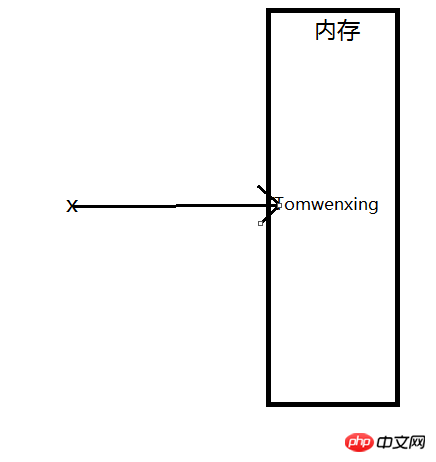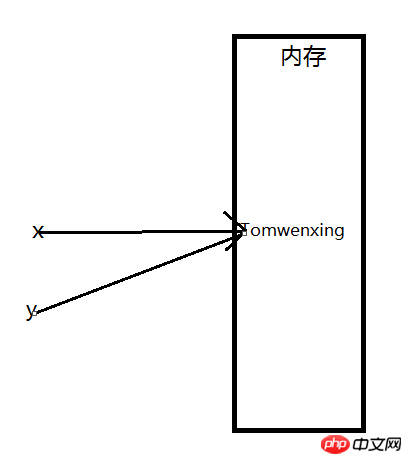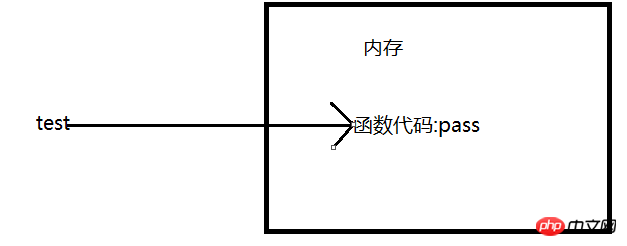Python decorator principle and usage analysis
This article mainly introduces the principle and usage of Python decorators, and analyzes the concepts, principles, usage methods and related operation precautions of Python decorators in the form of examples. Friends in need can refer to this article
Examples describe the principles and usage of Python decorators. Share it with everyone for your reference, the details are as follows:
1. The essence of the decorator is the function , which is mainly used to decorate other functions, that is, Add additional functions to other functions
2. Principles of decorators:
(1) Decorators cannot modify the source code of the decorated function
(2) Decorators cannot modify the calling method of the decorated function
3. Knowledge reserve for implementing decorators
(1) Functions in Python are 'variables'
a. Storage of variables in Python
x='Tomwenxing' y=x
[Explanation]:
##When the Python interpreter encounters the statement x='Tomwenxing' , it mainly completes two tasks:
## 1. Creates a space in the memory to store the string 'Tomwenxing'
2. Create a variable named x in the memory and use it to point to the memory space occupied by the string 'Tomwenxing' (can be understood as the room and room number Relationship)

That is, create a variable y in the memory and point it to the memory space pointed to by the variable x
 b. The function is in Storage in Python
b. The function is in Storage in Python
def test(): pass
In Python, the storage of functions is similar to variables. Take the above function as an example, Python explanation It mainly does two things:
1. Open up a memory space in the memory to store the string of the function code (in this example, the code has only one sentence: pass)
# 2. Create a variable test in the memory to point to the memory space where the function code string is stored(Equivalent to test='function body')

(2) Higher-order function (any one of the following two conditions is met to be a higher-order function)
a. Pass a function name as an actual parameter to another function
[Impact on decorators]: To achieve the effect of "adding functions to the decorated function without modifying its source code"import time
def bar():
time.sleep(2)
print('in the bar')
def test(func):
start_time=time.time()
func()
stop_time=time.time()
print('函数的运行时间为:',stop_time-start_time)
test(bar)
The running time of the function is: 2.0021145343780518b. The return value contains the function name
[Impact on decorators]: Achieve the effect of "not changing the calling method of the function"import time
def bar():
time.sleep(3)
print('in the bar')
def test2(func):
print('新添加的功能')
return func
bar=test2(bar)
bar()
in the bar(3) Nested function: Use def in a function body to declare a new function (not a call)
def foo():
print('in the foo')
def bar(): #声明一个新的函数,而不是调用函数
print('in the bar')
bar()
foo()Running result:
in the fooin the bar4. Decorator syntax: High-order function nested function => Decorator (the following example can use the pycharm debugger Debug it and see the running sequence of the code)
import time
def timer(func):
def deco(*args,**kwargs):#使用了不定参数
start_time=time.time()
res=func(*args,**kwargs) #运行函数
stop_time=time.time()
print('运行时间:',stop_time-start_time)
return res # 若无返回值,则返回None
return deco
@timer #等价于test1=timer(test1)=deco,即test1()=deco()
def test1():
time.sleep(3)
print('in the test1')
@timer #等价于test2=timer(test2)=deco,即test2(name)=deco(name)
def test2(name):
time.sleep(3)
print('in the test2',name)
test1()
print('-------------分界线------------------------')
test2('Tomwenxing')Running result:
in the test1Running time: 3.0001718997955322-------- -----Boundary line---------------------
5. Decorator with parameters
in the test2 Tomwenxing
Running time: 3.000171422958374
# -*- coding:utf-8 -*-
user,passwd='Tomwenxing','123'
#如装饰器带参数,一般是三层嵌套
def auth(auth_type): #第一层的参数是装饰器的参数
def outer_wrapper(func):#第二层的参数是装饰器要装饰的目标函数
def wrapper(*args,**kwargs):#第三次的参数是目标函数的参数
if auth_type=='local':
username = input('Username:').strip()
password = input('Password:').strip()
if user == username and passwd == password:
print('用户Tomwenxing已经成功登录!')
res = func(*args, **kwargs) #运行目标函数
return res
else:
exit('用户名或密码有错误')
elif auth_type=='ldap':
print('暂不支持这种登录方式!')
return wrapper
return outer_wrapper
def index():
print('欢迎来到index页面')
@auth(auth_type='local') #home=wrapper()
def home(name):
print('%s,欢迎来到home页面' %name)
return 'This is home page'
@auth(auth_type='ldap')
def bbs():
print('欢迎来到bbs页面 ')
index()
print('----------------------分界线-------------------')
print('函数的返回值为:',home('wenxing'))
print('----------------------分界线-------------------')
bbs()Running result:
Welcome to the index page------------ ----------Boundary line------------------Username:Tomwenxing
Password:123
User Tomwenxing has succeeded Log in!
wenxing, welcome to the home page
The return value of the function is: This is home page
----------------------Boundary line ------------------
This login method is not supported yet!
Related recommendations:
Use python decorator to calculate function running timePython iterator definition and simple usage analysisThe above is the detailed content of Python decorator principle and usage analysis. For more information, please follow other related articles on the PHP Chinese website!

Hot AI Tools

Undresser.AI Undress
AI-powered app for creating realistic nude photos

AI Clothes Remover
Online AI tool for removing clothes from photos.

Undress AI Tool
Undress images for free

Clothoff.io
AI clothes remover

AI Hentai Generator
Generate AI Hentai for free.

Hot Article

Hot Tools

Notepad++7.3.1
Easy-to-use and free code editor

SublimeText3 Chinese version
Chinese version, very easy to use

Zend Studio 13.0.1
Powerful PHP integrated development environment

Dreamweaver CS6
Visual web development tools

SublimeText3 Mac version
God-level code editing software (SublimeText3)

Hot Topics
 1385
1385
 52
52
 PHP and Python: Code Examples and Comparison
Apr 15, 2025 am 12:07 AM
PHP and Python: Code Examples and Comparison
Apr 15, 2025 am 12:07 AM
PHP and Python have their own advantages and disadvantages, and the choice depends on project needs and personal preferences. 1.PHP is suitable for rapid development and maintenance of large-scale web applications. 2. Python dominates the field of data science and machine learning.
 Python vs. JavaScript: Community, Libraries, and Resources
Apr 15, 2025 am 12:16 AM
Python vs. JavaScript: Community, Libraries, and Resources
Apr 15, 2025 am 12:16 AM
Python and JavaScript have their own advantages and disadvantages in terms of community, libraries and resources. 1) The Python community is friendly and suitable for beginners, but the front-end development resources are not as rich as JavaScript. 2) Python is powerful in data science and machine learning libraries, while JavaScript is better in front-end development libraries and frameworks. 3) Both have rich learning resources, but Python is suitable for starting with official documents, while JavaScript is better with MDNWebDocs. The choice should be based on project needs and personal interests.
 Detailed explanation of docker principle
Apr 14, 2025 pm 11:57 PM
Detailed explanation of docker principle
Apr 14, 2025 pm 11:57 PM
Docker uses Linux kernel features to provide an efficient and isolated application running environment. Its working principle is as follows: 1. The mirror is used as a read-only template, which contains everything you need to run the application; 2. The Union File System (UnionFS) stacks multiple file systems, only storing the differences, saving space and speeding up; 3. The daemon manages the mirrors and containers, and the client uses them for interaction; 4. Namespaces and cgroups implement container isolation and resource limitations; 5. Multiple network modes support container interconnection. Only by understanding these core concepts can you better utilize Docker.
 How to run programs in terminal vscode
Apr 15, 2025 pm 06:42 PM
How to run programs in terminal vscode
Apr 15, 2025 pm 06:42 PM
In VS Code, you can run the program in the terminal through the following steps: Prepare the code and open the integrated terminal to ensure that the code directory is consistent with the terminal working directory. Select the run command according to the programming language (such as Python's python your_file_name.py) to check whether it runs successfully and resolve errors. Use the debugger to improve debugging efficiency.
 Python: Automation, Scripting, and Task Management
Apr 16, 2025 am 12:14 AM
Python: Automation, Scripting, and Task Management
Apr 16, 2025 am 12:14 AM
Python excels in automation, scripting, and task management. 1) Automation: File backup is realized through standard libraries such as os and shutil. 2) Script writing: Use the psutil library to monitor system resources. 3) Task management: Use the schedule library to schedule tasks. Python's ease of use and rich library support makes it the preferred tool in these areas.
 Is the vscode extension malicious?
Apr 15, 2025 pm 07:57 PM
Is the vscode extension malicious?
Apr 15, 2025 pm 07:57 PM
VS Code extensions pose malicious risks, such as hiding malicious code, exploiting vulnerabilities, and masturbating as legitimate extensions. Methods to identify malicious extensions include: checking publishers, reading comments, checking code, and installing with caution. Security measures also include: security awareness, good habits, regular updates and antivirus software.
 What is vscode What is vscode for?
Apr 15, 2025 pm 06:45 PM
What is vscode What is vscode for?
Apr 15, 2025 pm 06:45 PM
VS Code is the full name Visual Studio Code, which is a free and open source cross-platform code editor and development environment developed by Microsoft. It supports a wide range of programming languages and provides syntax highlighting, code automatic completion, code snippets and smart prompts to improve development efficiency. Through a rich extension ecosystem, users can add extensions to specific needs and languages, such as debuggers, code formatting tools, and Git integrations. VS Code also includes an intuitive debugger that helps quickly find and resolve bugs in your code.
 How to install nginx in centos
Apr 14, 2025 pm 08:06 PM
How to install nginx in centos
Apr 14, 2025 pm 08:06 PM
CentOS Installing Nginx requires following the following steps: Installing dependencies such as development tools, pcre-devel, and openssl-devel. Download the Nginx source code package, unzip it and compile and install it, and specify the installation path as /usr/local/nginx. Create Nginx users and user groups and set permissions. Modify the configuration file nginx.conf, and configure the listening port and domain name/IP address. Start the Nginx service. Common errors need to be paid attention to, such as dependency issues, port conflicts, and configuration file errors. Performance optimization needs to be adjusted according to the specific situation, such as turning on cache and adjusting the number of worker processes.




